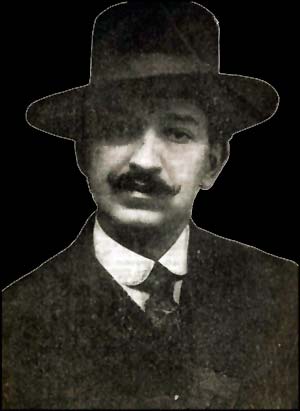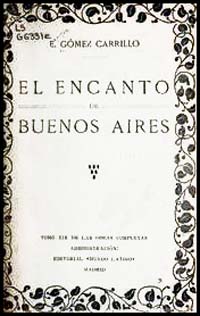By
Enrique Gómez Carrillo and his advocacy on behalf of tango

nrique Gómez Carrillo was a journalist and chronicler who was born in Guatemala in 1873 and passed away in Paris in 1927. A man fond of traveling, author of numerous books, a quantity that exceeds one hundred, today may be regarded as an almost forgotten writer. Among his books, several about travels, the city of Buenos Aires was also among his visits and about it he wrote the book El Encanto de Buenos Aires, released in 1914, which included a chapter called El Tango.
 He married several times, the last of his wives was a beauty from El Salvador, Consuelo Suncin, who later was the wife of the famous French aviator Antoine de Saint Exupéry, the author of Le Petit Prince, who disappeared in a reconnaissance mission in 1944, in France, and was pilot in our country, in the Patagonian region, in the 30s, a frequent attendee to the Chantecler and the Armenonville and he used to say to whoever was likely to hear him: «I like only Argentine tango».
He married several times, the last of his wives was a beauty from El Salvador, Consuelo Suncin, who later was the wife of the famous French aviator Antoine de Saint Exupéry, the author of Le Petit Prince, who disappeared in a reconnaissance mission in 1944, in France, and was pilot in our country, in the Patagonian region, in the 30s, a frequent attendee to the Chantecler and the Armenonville and he used to say to whoever was likely to hear him: «I like only Argentine tango».
About our music, Gómez Carrillo wrote, after a visit to a cheap venue in La Boca in which he was accompanied by an Argentine called Thuiller and the Spanish novelist Vicente Blasco Ibáñez, the author of Sangre y arena (Blood and Sand) and Los cuatro jinetes del apocalipsis (The Four Horsemen of the Apocalypse). In that writing Gómez Carrillo criticized the vision that foreigners had about our urban music and also the one held by some writers like Leopoldo Lugones, Enrique Larreta or Ezequiel Martínez Estrada, without mentioning them, who on some occasion anathematized Argentine tango and its wide spreading.
The above author writes, making a lucid description of ambience in this tango page we have rescued:
«The dive we have just got into turns out worse than cheap. It is a huge room with no ornament, not even paper on the walls and scarcely lit by some gas burners. At the background, in a sort of wooden cage, six musicians are getting their instruments ready. Piled around some dirty tables, a hundred of patrons drink, talk and laugh. At the beginning it is difficult to become aware of the people’s appearance. The men, skinny and young, in general, with their derby hats and their long hair poking out behind, seem to fit what is called the «compadrito» type.
And the writer goes on: «The women form a more heterogeneous human group. There are some who turn out just children, with their wide open candid eyes on their rosy faces, and there are some with grandmothers’ faces, in such a way that their age is branded in the wrinkles of their cheeks. But the most disturbing ones– and the most interesting too –are neither the former nor the latter, but the skinny, pale, baggy-eyed, snake-like girls that, with a uniform smile, look at all the ones who enter in a spectral and provoking way».
 «The attractive rags of the female sinners are, in fact, as varied as their kinds. There are fat and mature women who display Claudinas’ costumes with boastful pride, exposing their round calves with an air that tries to be childish and it is no other thing but a vile gesture. There are also young girls, with exaggerated make-up and quite coquette air, who perform the sad miracle of appearing elegant with ten-year-old clothes. There are naïve gentle women who tie a dancing bodice to a skirt tailleur. And there are those who, renouncing to all struggle, proclaim, with their regrettable neglect, the misery of the supreme defeats…».
«The attractive rags of the female sinners are, in fact, as varied as their kinds. There are fat and mature women who display Claudinas’ costumes with boastful pride, exposing their round calves with an air that tries to be childish and it is no other thing but a vile gesture. There are also young girls, with exaggerated make-up and quite coquette air, who perform the sad miracle of appearing elegant with ten-year-old clothes. There are naïve gentle women who tie a dancing bodice to a skirt tailleur. And there are those who, renouncing to all struggle, proclaim, with their regrettable neglect, the misery of the supreme defeats…».
And Gómez Carrillo tells us about the music that is heard when the orchestra begins to play: «It is the same I have heard around the world, at any hour; it is the classic tango, it is the one well-known by people, it is the one that even the street organs of Orient know how to play». And the writer praises that those same tango music notes are those which help Parisian women at their parties where they dance to the beat of the porteño tango. Those same music notes we hear at this cheap venue are the ones of the tango which succeeds in Paris every evening.
And the couples dance, grouping together ten or twelve of them. «And they pass before my eyes with no hurry, nor violence, almost without enthusiasm, counting, no doubt, the steps, getting ready for the cortes, paying attention in not making mistakes… And little by little the atmosphere is enlivened, not with the ardent life of the Madrid Bombilla, where the couples hold each other in close hugs, but with the somewhat artful theatrical fever of the Parisian tea parties…»
And he added: «…Watching these couples come and go, I wonder what can be the reasons why this dance has caused not only the anathemas by the bishops, but also a dispute in the Buenos Aires society». And he also says «And when somebody says that in an Argentine embassy there was a tango dancing one evening, His Excellency, the ambassador orders to send a cable to his country, complaining for such slander. “This smears the reputation of our ladies”, one of the most honorable spirits of our country has written…»
And Gómez Carrillo, after his visit to this poor local in a neighborhood where tango was also born, says in its defense: «… That…? On the contrary. That, at the bouge (dive) where we previously used to see misery and vice, exasperation and sordidness, has created, on the spot, with the magic of its paused majestic beat, which seems to enlarge silhouettes and sharpen waists, an atmosphere of gallant, mundane and restrained festivity».
Lastly: «… In these couples I recognise, in fact, neither the compadritos with the derby hats up to their ears nor the sad female sinners with their ridiculous rags. Without embracing each other, almost without touching each other, watching their steps instead of their faces, they smile with a grave smile, the same on all their lips, and swaying complicated steps, as if they were celebrating a rite of ceremonious harmonies».
Gómez Carrillo asks at the end of this chapter: «Where’s the sin, where’s the perversity, where’s the lust in this dance? Furthermore: Where is the voluptuous giving in to passion of nearly all the Viennese waltzes?»
Bibliography
Aira, César. Diccionario de Autores Latinoamericanos. Emecé, Buenos Aires, 2001.
Gómez Carrillo, Enrique. El encanto de Buenos Aires, Madrid, 1914
Se dijo del tango. Revista Tanguera. Nº 30 Buenos Aires, without date of release (ca.1962).